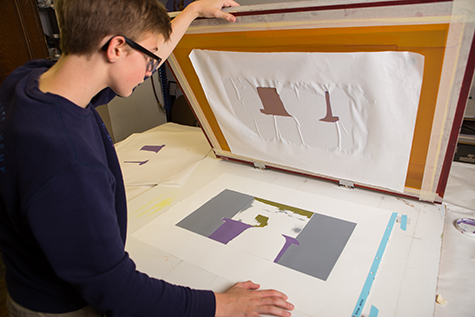The Vital Overview to Understanding Screen Printing and Its Versatile Uses
Screen printing has a rich history that goes back to old times, evolving into an advanced method made use of throughout numerous industries today. This guide explores the ins and outs of the screen printing procedure, describing its applications in advertising, fashion, and home style - 10:9 Design Screen Printing Texas. Comprehending these basics can open up innovative potential for both industrial and artistic tasks. The adhering to areas will certainly disclose crucial pointers and strategies to improve one's screen printing ventures
The History of Screen Printing
Although screen printing has roots that map back centuries, its evolution mirrors the artistic and technical innovations of different cultures. Coming from ancient China, the strategy was at first made use of for embellishing textiles and later infect Japan, where it ended up being indispensable to Ukiyo-e woodblock printing. The approach moved to Europe in the 18th century, where it gained appeal among craftsmens and commercial printers. The creation of picture emulsion in the 20th century changed screen printing, enabling for even more elaborate layouts and higher performance. Musicians like Andy Warhol even more propelled its appeal, using the medium to create iconic works that combined commercialism and fine art. By the late 20th century, screen printing had actually established itself as a flexible strategy, employed in style, advertising, and art. Today, it proceeds to develop, incorporating electronic technology and broadening its applications throughout various sectors.
The Screen Printing Refine Explained
Screen printing changes artistic visions into substantial layouts through a series of exact actions. An image is produced and after that moved onto a screen, commonly made of fine mesh fabric stretched over a frame. A light-sensitive emulsion is put on the screen, which is revealed to light, setting in locations not covered by the picture. After rinsing the unhardened solution, a pattern is created.
Next off, the screen is put over the substrate, whether it be textile, paper, or another material. Ink is after that pressed through the open locations of the pattern making use of a squeegee, transferring the layout onto the substrate listed below. This process can be repeated for several colors, needing separate screens for every hue. The printed item is healed using heat to guarantee the ink sticks effectively, resulting in a sturdy, lively style ready for use.
Kinds of Screen Printing Techniques

Additionally, specialty techniques, such as discharge screen printing, eliminate dye from the material to produce softer prints, while aluminum foil screen printing uses metallic foil to achieve a shiny finish (10:9 Design Texas). Each method provides unique characteristics, accommodating different creative needs and production ranges, inevitably increasing the opportunities within the screen printing domain name
Applications of Screen Printing in Numerous Industries

Furthermore, the signage and marketing markets use screen printing for developing attractive displays and banners. This method enables vibrant shades and complex styles that capture focus. In electronics, screen printing is employed for using conductive inks to circuit card, vital for component links. In addition, the home style market embraces screen printing to create distinctive layouts on fabrics and wall art. Overall, screen printing functions as a vital tool throughout diverse areas, improving items with personalized and visually attractive graphics.
Tips for Effective Screen Printing Projects
While carrying out a screen printing task, careful focus to detail can substantially enhance the last result. Initially, choosing top quality products is important; this consists of the screen, inks, and substrates. Utilizing appropriate mesh counts can influence ink deposition and detail resolution. Preparation is equally crucial; thorough cleaning of displays and proper exposure times assure crisp prints.
Next off, accurate enrollment is important for multi-color prints. Using alignment devices can aid achieve exact layering. Additionally, testing prints on scrap products before manufacturing helps determine possible concerns without squandering sources.

Regularly Asked Concerns
What Products Are Finest for Screen Printing on Textile?
Cotton and polyester blends are suitable for screen printing on fabric as a result of their resilience and ink absorption. In addition, specialized textiles like silk or canvas can create unique structures and finishes, improving the total design quality.
Just how Do I Clean and Maintain Screen Printing Devices?
To preserve and cleanse screen printing equipment, one must frequently clean displays with suitable solvents, check squeegees for wear, lube relocating parts, and store all products in a completely dry, dust-free environment to extend their life-span.
What Are the Environmental Effects of Screen Printing?
Screen printing can have substantial environmental impacts, including chemical waste from solvents and inks, water usage during cleaning procedures, and energy usage. Lasting methods and environmentally friendly products are necessary for reducing these unfavorable results.
Can Screen Printing Be Done in the house Effectively?
Screen printing can be efficiently done at home with the ideal products and strategies. Enthusiasts can develop top quality prints, though success relies on their ability degree, tools, and understanding of the procedure entailed.
What Are the Prices Linked With Beginning a Display Printing Business?

Starting a screen printing company entails costs for devices, products, and workspace. First costs normally range from a few hundred to several thousand bucks, depending upon the scale, top quality of equipment, and desired manufacturing capability.
Screen printing has a rich background that dates back to ancient times, evolving right into an advanced technique made use of across numerous markets today. Another strategy, rotary screen printing, uses cylindrical displays, promoting constant printing on textile rolls, consequently enhancing effectiveness for large-scale manufacturings. Additionally, specialized strategies, such as discharge screen printing, eliminate dye from the material to create softer prints, while aluminum foil screen printing applies metal aluminum foil to accomplish a glossy surface. In the style sector, screen printing is extensively used to develop dynamic layouts on apparel, making it possible for brands to display their unique designs. Cotton and polyester blends are ideal for screen printing on material due to their sturdiness and ink absorption.